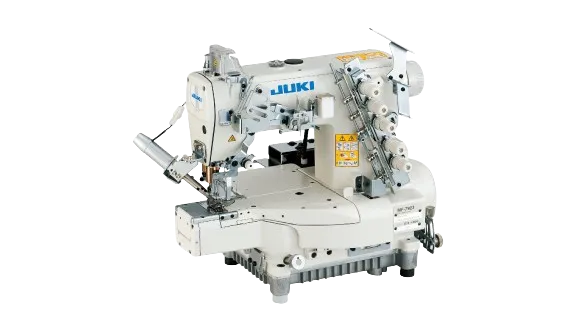Sewing enthusiasts often encounter the dilemma of choosing between overlock and interlock sewing machines. Overlock and interlock sewing machines are valuable additions to any sewing space, offering unique features and capabilities. This comprehensive guide will explore the differences between overlock vs interlock sewing machines to help you decide based on your sewing needs and preferences.
Understanding Overlock and Interlock Sewing Machines
When choosing a sewing machine, it’s important to understand the differences between an overlock vs interlock sewing machine. Both serve unique purposes in finishing seams and edges for various fabrics.
What is an Overlock Sewing Machine?
An overlock sewing machine is designed to sew over the edge of fabrics, creating a clean, finished seam. It prevents fabric from fraying and offers a professional-looking edge by using multiple threads, making it essential for creating durable, neat seams.
What is an Interlock Sewing Machine?
An interlock sewing machine is similar to an overlock but primarily used for knit fabrics. It creates a strong, stretchable seam by interlocking threads, making it ideal for sewing stretchy materials like jerseys and ensuring the seams retain their stretchability and durability.

Understanding Overlock Sewing Machines
Imagine an agile sprinter whizzing through fabric edges, leaving them neatly trimmed, serged, and ready for action. That’s the overlock machine, also known as a serger. Its primary focus is finishing raw edges, preventing fraying, and creating professional-looking seams.
Definition and Functionality:
An overlock sewing machine is designed to create professional-looking seams and finishes on fabric edges. It trims excess seam allowance while simultaneously encasing the raw edge with thread, preventing fraying.
Features:
Overlock machines typically offer multiple threads (ranging from 2 to 5) and various stitch options, including overedge rolled hem, picot hemming, and blind stitches.
Applications:
Overlock Sewing machines are ideal for sewing all kinds of fabrics:
Four threads are used for knit fabrics, finishing seam edges, creating decorative edges, and assembling garments quickly and efficiently.
Five thread is used for Woven and heavy fabrics such as Denims.
Multiple threads:
Overlockers use 3-5 threads to create intricate stitches that encase the raw edge while trimming excess fabric. This produces stronger, cleaner, and more elastic seams than single-needle sewing machines.
Variety of stitches:
From basic overlock stitches to decorative rolled hems and flatlocks, overlockers offer versatility for various finishing tasks.

Exploring Interlock Sewing Machines:
Picture a powerful weightlifter, effortlessly handling stretchy fabrics and creating flat, secure seams. That’s the interlock machine, also known as a flatlock or cover stitch
machine. Its focus is on stitching seams in knitwear, creating professional-looking finishes with added strength and stretch.
Definition and Functionality:
An interlock sewing machine, also known as a cover stitch machine, is primarily used for hemming and topstitching knit fabrics. It creates a double/triple-needle, straight stitch on the top layer of fabric with a serger or overlock stitch on the underside.
Features:
Interlock machines typically feature three needles and one looper, allowing cover stitch to form. Some models may offer additional features like differential feed and adjustable stitch length.
Applications:
Interlock sewing machines excel in creating professional-looking hems on garments, attaching elastic, sewing decorative topstitching, and constructing activewear and knitwear.
Multiple needles:
Interlocks typically have 2-4 needles, creating flat, overlapping stitches that lie flat on stretchy fabrics.
Chain stitch:
This unique type offers excellent strength and stretch, ideal for garments that need to move freely.
Key Differences Between Overlock Vs. Interlock Machines:
Here are the key differences between overlock and interlock sewing machines:
Stitch Formation:
– Overlock industrial sewing machines produce a serged stitch that simultaneously trims and encases fabric edges, creating secure and neat seams.
– Interlock sewing machines specialize in creating a cover stitch, primarily used for hemming and topstitching knit fabrics. The stitch is formed by two/three needles on the top layer and a looper underneath, resulting in a professional-looking finish.
Seam Finishes:
– Overlock sewing machines are designed for finishing raw edges and creating secure seams, making them ideal for garment construction and edge finishing.
– Interlock sewing machines excel in producing neat and stretchy hems, making them suitable for hemming knitwear and activewear.
Versatility:
– Overlock machines offer a wide range of stitch options, including overedge, rolled hem, and flatlock stitches, making them versatile for various sewing tasks.
– Interlock machines are primarily used for hemming and topstitching knit fabrics, limiting their versatility compared to overlock machines.
Factors to Consider When Choosing Between Overlock and Interlock Machines:
Types of Projects:
Determine the primary sewing projects you’ll work on and choose a machine that best suits your needs.
Budget:
Consider your budget and invest in a machine that offers the required features and capabilities within your price range.
Space and Storage:
Assess the available space in your sewing area and choose a machine that fits comfortably within your workspace.
Conclusion
Overlock and interlock sewing machines play crucial roles in garment construction and finishing. Understanding the differences between these machines and evaluating your sewing requirements will help you choose the right one for your projects. Whether you opt for an overlock machine for versatile seam finishes or an interlock machine for professional hemming, investing in the right sewing equipment will enhance your sewing experience and elevate the quality of your creations. As a provider of sewing machines, Balaji Sewing Machine offers sturdy machines that produce precise stitches to support creating one-of-a-kind products. Visit our website to discover more about the various overlock and interlock sewing machines and their unique characteristics.

